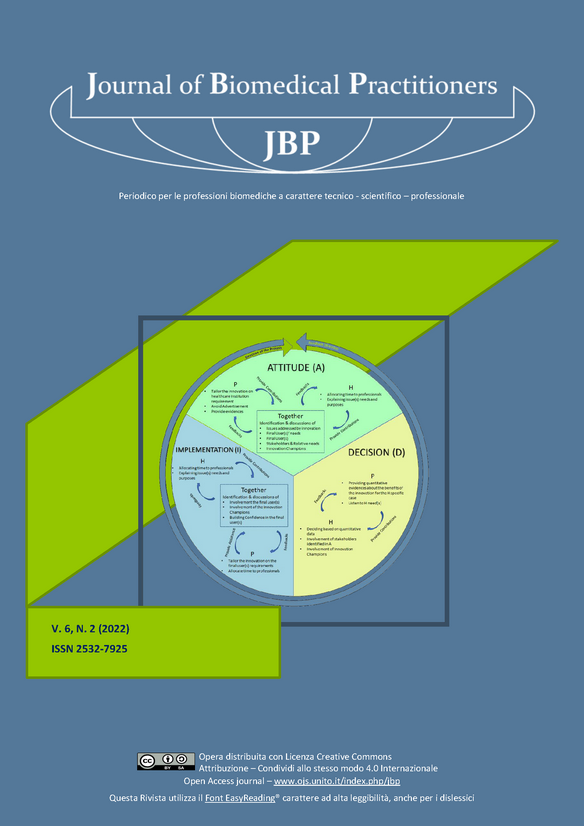Latency changes in somatosensory evoked potentials related to the contextualization of hypnotic suggestions.
Main Article Content
Abstract
OBJECTIVE
The evaluation of the difference in latency of two somatosensory evoked potentials (SEPs) of two different verbal suggestions:
- situations where relaxation is induced by a simple verbal suggestion not described as “hypnotic” (control group, IMC).
- situations where relaxation is induced by hypnotic suggestions explicitly described as such (experimental group, IPN), is the goal on which the present study has been focused.
MATERIALS AND METHODS
A pool of participants (N=28; Male =15; Female =13) was randomly divided into two groups (IMC and IPN). After the electrodes placement (EEG montage), all participants received 200 somatosensory electrical stimulations on the left or right wrists, in two conditions, a Baseline and a Test. Before the Test condition, participants of the IMC group received suggestions related to the reduction of the somatosensory perception not explicitly contextualized as “hypnotic”, while participants of the IPN group received the same suggestions contextualized as hypnotic suggestions. Valuation of the latency of P1 and N2 potentials was made, for both phases and both sides.
RESULTS
The data collected showed that only in the IPN group, where relaxation was obtained through hypnotic techniques described and contextualized as such, was possible to observe a significantly slower latency for both potentials (P1 and N2), after stimulation of the right wrist.
CONCLUSIONS
The study results seem to suggest that the efficacy related to hypnotic suggestions significantly relies on the contextualization of the situation, where suggestions are given as “hypnotic”. This contextualization is measurable through electrophysiological dimensions such as evoked potentials’ latency.
Downloads
Article Details
The authors agree to transfer the right of their publication to the Journal, simultaneously licensed under a Creative Commons License - Attribution that allows others to share the work indicating intellectual authorship and the first publication in this magazine.
References
[2] Barber, T. X., & Calverley, D. S. (1964). Toward a theory of hypnotic behavior: Effects on suggestibility of de-fining the situation as hypnosis and defining response to suggestions as easy. The Journal of Abnormal and Social Psychology, 68(6), 585–592. https://doi.org/10.1037/h0046938
[3] Carlino, E., Torta, D. M., Piedimonte, A., Frisaldi, E., Vighetti, S., & Benedetti, F. (2015). Role of explicit ver-bal information in conditioned analgesia. European journal of pain (London, England), 19(4), 546–553. https://doi.org/10.1002/ejp.579
[4] Desmedt, J. E., & Cheron, G. (1981). Non-cephalic reference recording of early somatosensory potentials to finger stimulation in adult or aging normal man: differentiation of widespread N18 and contralateral N20 from the prerolandic P22 and N30 components. Electroencephalography and clinical neurophysiology, 52(6), 553–570. https://doi.org/10.1016/0013-4694(81)91430-9
[5] Erickson, M. H., Haley, J., & Ferrazzi, F. (1978). Le nuove vie dell'ipnosi: induzione della trance, ricerca spe-rimentale, tecniche di psicoterapia. Astrolabio
[6] Erickson, M. H., Rosen, S. (1983). La mia voce ti accompagnerà. I racconti didattici. Astrolabio
[7] Erickson, M. H., & Rossi, E. L. (1982). Ipnoterapia. Astrolabio Ubaldini
[8] Frisaldi, E., Piedimonte, A., & Benedetti, F. (2015). Placebo and nocebo effects: a complex interplay between psychological factors and neurochemical networks. The American journal of clinical hypnosis, 57(3), 267–284. https://doi.org/10.1080/00029157.2014.976785
[9] Giuliano, L. M., Nunes, K. F., & Manzano, G. M. (2012). The P18 component of the median nerve SEP recorded from a posterior to anterior neck montage. Clinical neurophysiology: official journal of the International Federa-tion of Clinical Neurophysiology, 123(10), 2057 2063.https://doi.org/10.1016/j.clinph.2012.03.010
[10] Hlushchuk, Y., & Hari, R. (2006). Transient suppression of ipsilateral primary somatosensory cortex during tac-tile finger stimulation. The Journal of neuroscience: the official journal of the Society for Neuroscience, 26(21), 5819–5824. https://doi.org/10.1523/JNEUROSCI.5536-05.2006
[11] Mazzoni, G., Venneri, A., McGeown, W. J., & Kirsch, I. (2013). Neuroimaging resolution of the altered state hypothesis. Cortex: A Journal Devoted to the Study of the Nervous System and Behavior, 49, 400–410.doi:10.1016/j.cortex.2012.08.005
[12] McGeown, W. J., Mazzoni, G., Venneri, A., & Kirsch, I. (2009). Hypnotic induction decreases anterior default mode activity. Consciousness and Cognition, 18, 848–855. doi:10.1016/j.concog.2009.09.001
[13] Kirenskaya, A. V., Storozheva, Z. I., Solntseva, S. V., Novototsky-Vlasov, V. Y., & Gordeev, M. N. (2019). AUDITORY EVOKED POTENTIALS EVIDENCE FOR DIFFERENCES IN INFORMATION PROCESSING BETWEEN HIGH AND LOW HYPNOTIZABLE SUBJECTS. The International journal of clinical and experimental hypnosis, 67(1), 81–103. https://doi.org/10.1080/00207144.2019.1553764
[14] Passmore, S. R., Murphy, B., & Lee, T. D. (2014). The origin, and application of somatosensory evoked poten-tials as a neurophysiological technique to investigate neuroplasticity. The Journal of the Canadian Chiropractic Association, 58(2), 170–183
[15] Spiegel, D. (2013). Tranceformations: Hypnosis in brain and body. Depression and Anxiety, 30(4), 342–352. https://doi.org/10.1002/da.22046
[16] Srzich, A. J., Cirillo, J., Stinear, J. W., Coxon, J. P., McMorland, A., & Anson, J. G. (2019). Does hypnotic susceptibility influence information processing speed and motor cortical preparatory activity?. Neuropsychologia, 129, 179–190. https://doi.org/10.1016/j.neuropsychologia.2019.03.014
[17] Weitzenhoffer, A. M., Hilgard, E. R. (1959). Stanford hypnotic susceptibility scale: forms A and B, for use in research investigations in the field of hypnotic phenomena. Consulting Psychologists Press. Palo Alto, California
[18] Yamada, T., Kameyama, S., Fuchigami, Y., Nakazumi, Y., Dickins, Q. S., & Kimura, J. (1988). Changes of short latency somatosensory evoked potential in sleep. Electroencephalography and Clinical Neurophysiology, 70(2), 126–136. https://doi.org/10.1016/0013-4694(88)90113-7

